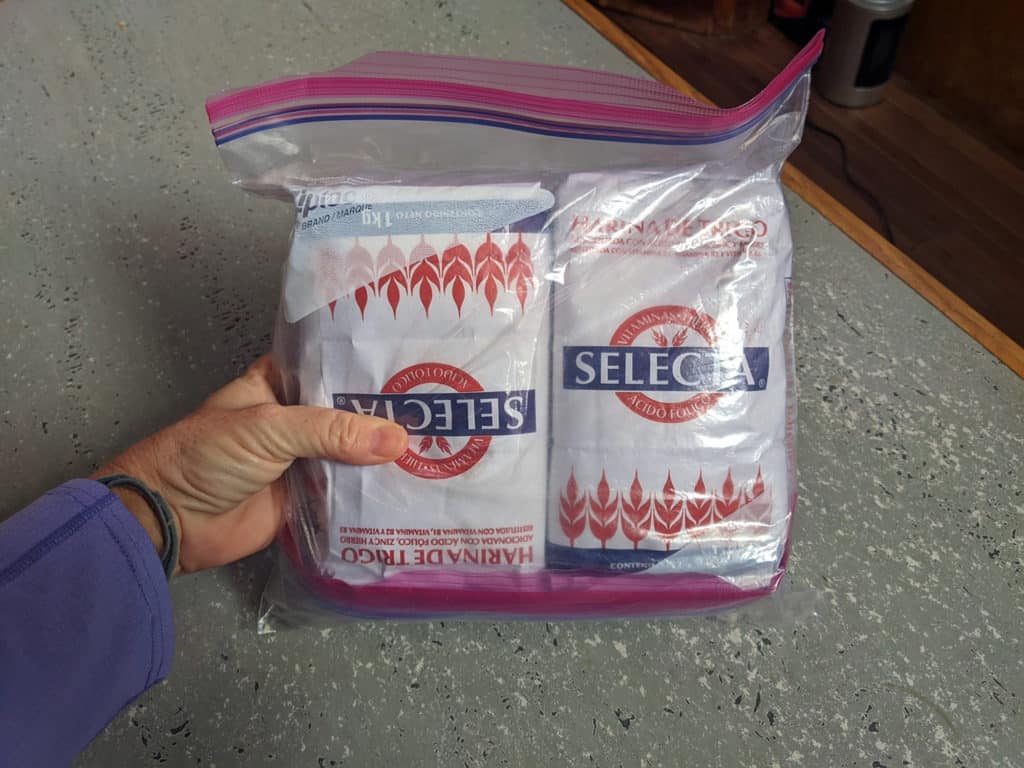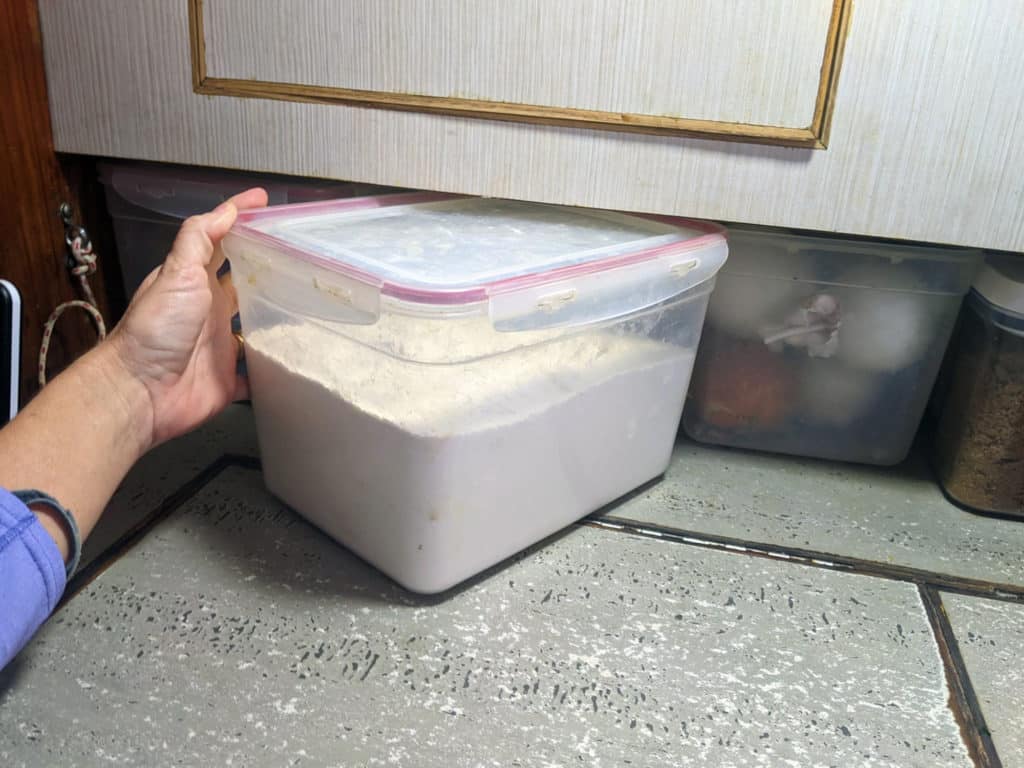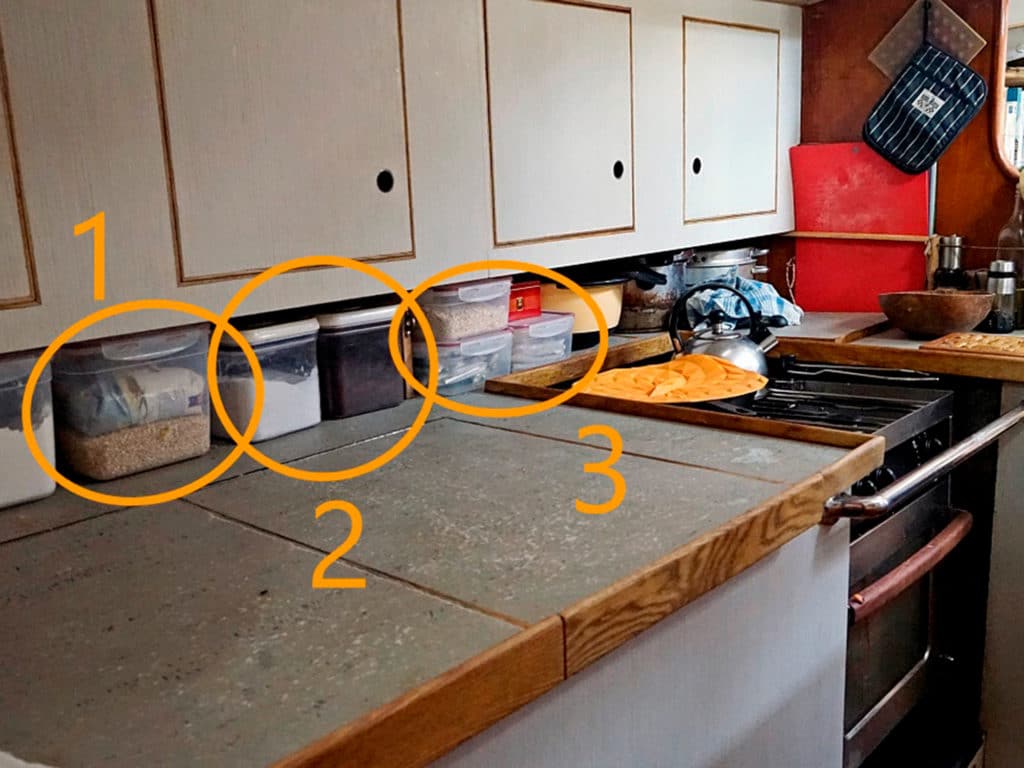
Creepy-crawly calamity struck as we departed Tonga. Totem was a little over halfway across the South Pacific along our 2010 route from Mexico to Australia: next stop Fiji, about 400 miles to the west. We started the passage with a crew-pleasing breakfast, skillet biscuits! Except when I pulled a bag out to stir them up, I saw something move… and then another something… and then I realized the flour was literally crawling with weevils.
The flour I’d provisioned in Mexico about five months previously had finally run out a few weeks before; I bought new bags of all-purpose in Vava’u. Every bag I opened that morning had insects; one by one, the squirmy fish food went overboard. This was not a great way to start the passage to Fiji!
Our bug-infestation prevention game has stepped way up since then. Here’s a rundown of our go-to tactics to keep bugs out of the dry good stores they go for: grains, flours, pastas— to keep pantry lockers bug-free.
Assume There Are Eggs
Always assume that there are insect eggs inside those dry goods you’re buying. I know, gross, but it’s reality! Weevil eggs can be dormant for months, lurking in the stores you innocently purchase, waiting for the right conditions to hatch: air, humidity, warmth. Conditions inconveniently triggered by opening up a package.
In Tonga, small shops sold staples like flour by decanting bulk purchases into smaller bags. That’s probably why it looked fine when I bought it, but was crawling with bugs not long after.
Isolate For Long-Term Storage
For that reason, I avoid buying in larger quantities unless we really are provisioning for many months. Then, I’ll buy rice or flour in one-kilogram (about two pound) bags, then double-bag those in heavy-weight (freezer) Ziplocs, Only then do I put them in a locker. Weevils can chew through soft plastic packaging, but more layers mean farther to go before infesting across different food stores.
In March last year, I bought flour estimated to last six months, based on the assumption we’d either be away from shops because of sailing into the South Pacific, or isolating for COVID. It turned out to be the latter. At the end of six months, only one had weevils (and they only spread to the “companion” bag in the Ziploc, sparing other stores in the locker).

And in Fiji, it happened again: bugs in the rice this time! Rice that had been stored next to the flour for about a week. Weevils can eat through plastic; it probably was not coincidence.
Additional Measures
There are additional steps to take (and a few conventional methods I don’t think work) to kill eggs or insects already present in provisions.
Use heat. Microwaving flour is said to kill eggs, but not all pantry stores can be microwaved (e.g., seeds for sprouting). Some sources say 28 seconds at 500 watts is enough; others recommend five minutes (which seems excessive?). We don’t have a microwave and haven’t used this tactic. But we have used our solar oven! In 2010, it killed lice nits in bedding that our kids inadvertently brought on the passage from Mexico to French Polynesia.
Use cold. Some folks swear by putting a bag of rice or flour or whatever in the freezer to kill eggs. Prepper sources suggest it takes three to seven days in a freezer. That sounds inconvenient, but I’d still try it if we had the capacity. But our freezer’s not much bigger than a shoebox and inconsistently cold (it makes ice but won’t keep ice cream hard). Friends were clever enough to request freezer space from a hotel’s restaurant.
Vacuum sealing. A friend who battled with weevils while crossing the Pacific found that none of her vacuum-sealed bags had vermin. The theory here is oxygen deprivation, which prevents eggs from hatching.
Alcohol. Another recommends putting an alcohol-soaked cotton ball inside a Ziploc, sealed container or vacuum sealed bag, in an effort to kill any eggs within—but all the information I find on this is anecdotal.
Bay leaves. Fragrant Laurus nobilis is supposed to deter bugs when tucked into a container. I used bay leaves for years, and could never tell if they worked. People feel good because they’re doing something, but I don’t believe this is effective.
Even though we don’t rely on any of these bonus methods for getting rid of bugs in our dry stores, we’ve never had a major problem on board. Although it’s worth acknowledging that tolerance around this varies! We’ve also been known to soak rice so the “floaters” can get picked out, when there are just a few…
Airtight Bins for Frequent Use
What happens when you want to start using these bulk stores you’ve carefully packed away? We have a range of containers where we decant frequently used pantry items from bulk storage, that live on the counter in Totem’s galley.
The larger, airtight containers with gasketed lids are for flour and rice (each one holds about 10 pounds). I think these are Sterilite bins I bought back in Thailand, in 2014. When I open a bag, I assume I’ve fast-forwarded any possibility of eggs hatching.

Our gasketed bins are a mystery brand bought in Thailand in 2014, but nearly identical in size and features to these Sterilite tubs. Other popular brands with similar features are Snap & Lock (best deals on these at Costco), Sistema, and Lock & Lock.
Meanwhile, those airtight bins helps keep anything that does hatch from spreading. Did you know weevils can eat through cardboard, paper and even aluminum packaging? Voracious little buggers!

Back on Totem…There’s a lot of re-imagining going on in our galley right now: We have to replace the counters, and the stove. That opens up all kinds of possibilities. I’m thinking about replacing our current larger “bug proof” containers with a new set that’s large and measured to fit the space well. After six years some of the silicon gaskets in our standbys are starting to fail. A great useful life! And a nice opportunity to continue adapting the spaces aboard to our needs.








